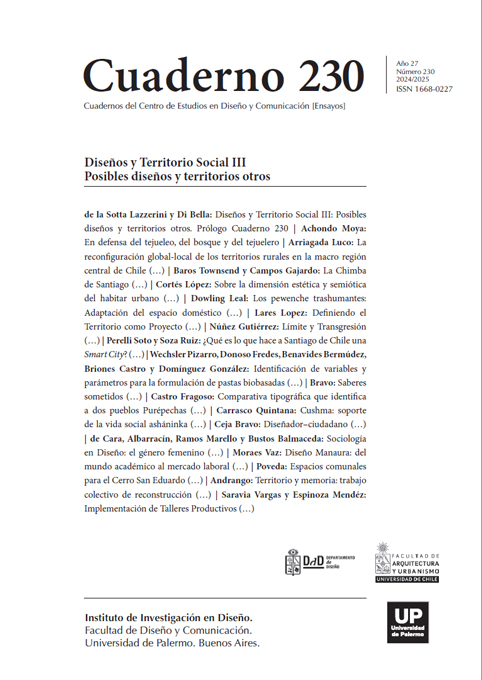Definiendo el Territorio como Proyecto, enfoque de diseño regenerativo para proyectar futuros alternativos de cohabitar socio-ecológico
Resumo
As evidências científicas são irrefutáveis e demonstraram o impacto da atividade humana no planeta, mostrando que os modos de vida dominantes não são sustentáveis, desencadeando o esgotamento de recursos, a superprodução, o consumo excessivo e a superabundância de resíduos que contribuíram para a atual crise ambiental e social.
Referências
Calle, V. (2023) El diseño regenerativo local para la transición, un enfoque desde la biomímesis. Cuadernos del Centro de Estudios de Diseño y Comunicación N°195 (Pp. 167-180). DOI: https://doi.org/10.18682/cdc.vi195.9637.
Cole, R., Oliver, A., Robinson, J (2013) Regenerative design, socio-ecological systems and co-evolution. Building Research and Information. 41(2):237-247.
Cooper, I. (2012) Winning hearts and minds or evidence-driven: Which trajectory for regenerative design? Building Research and Information 40(3):1-4.
Clegg, P. (2012) A practitioner’s view of the ‘Regenerative Paradigm’, Building Research & Information, 40:3, 365-368.
Escobar, A. (2018) Designs for the Pluriverse: Radical Independencen, Autonomy, and the Making of Worlds. Duke University Press Books.
Escobar, A. (2016) Autonomía y Diseño, la realización de lo comunal. Popayán. Editorial Universidad del Cauca.
Fazey, I, et al (2018) Ten essentials for action-oriented and second order energy transitions, transformations and climate change research. Energy Research & Social Science. Volumen 40. pp 54-70.
Fuad-Luke, A. (2013) Design Activism: A Beautiful Strangeness for a Sustainable World. 1-245. 10.4324/9781849770941.
Gutiérrez Borrero, A., (2015) Resurgimientos: sures como diseños y diseños otros. Nómadas (Col), (43), 113-129.
Halvorsen, Sam. (2018) Decolonising territory: Dialogues with Latin American knowledges and grassroots strategies. Progress in Human Geography. 43. 030913251877762.10.1177/0309132518777623.
Haraway, D. (2019) Seguir con el problema: generar parentesco en el Chthuluceno. Bilbao: Consonni.
Haraway, D. (2020) Cuentos para la supervivencia terrenal. Recuperado de https://lalulula.tv/cine/100076/donna-haraway-cuentos-para-la-supervivencia-terrenal
Haraway, D. (1988). Situated Knowledges: The Science Question in Feminism and the Privilege of Partial Perspective. Feminist Studies. Vol. 14, No. 3. pp. 575-599
Harvey, D. (2017) (capítulo primero, pp. 1-23, de) Marx, El capital y la locura de la razón económica. Akai, cuestiones de antagonismos / 109. Argentina
Irwin, Terry, Tonkinwise, Cameron, & Kossoff, Gideon. (2022) Transition Design: An Educational Framework for Advancing the Study and Design of Sustainable Transitions. Cuadernos del Centro de Estudios en Diseño y Comunicación. Ensayos N°105, Pp.31-72. Epub 01 de marzo de 2022. DOI: https://dx.doi.org/10.18682/cdc.vi105.4188
Latour, B. (2008) Reensamblar lo social: una introducción a la teoría del actor-red (1a ed.). Buenos Aires: Manantial.
Mang, P., Reed, B. (2012) Regenerative Development and Design. 2nd edition. ResearchGate.
Mang, P., Reed, B. (2012) Designing from place: A regenerative framework and methodology. Building Research & Information. 40. 23-38. 10.1080/09613218.2012.621341.
McDonough, W., Braungart. M. (2002) Cradle to cradle: remaking the way we make things. New York: North Point Press.
McKinney, L., & Moore, J. W. (2017) [Review of Capitalism in the Web of Life: Ecology and the Accumulation of Capital]. Human Ecology Review, 23(1), 205–210. (Disponible en: https://www.jstor.org/stable/26367971).
Moore, J. (2016) Anthropocene or Capitalocene? Nature, History, and the Crisis of Capitalism. Recuperado de https://www.researchgate.net/publication/301301869_Anthropocene_or_Capitalocene_Nature_History_and_the_Crisis_of_Capitalism.
Puig de la Bellacasa, M. (2012) ‘Nothing Comes Without Its World’: Thinking with Care. The Sociological. Recuperado de https://www.researchgate.net/publication/263529571_’Nothing_Comes_Without_Its_World’_Thinking_with_Care#fullTextFileContent.
Koskinen, I. et al. (2011) Design Research Through Practice. Elsevier Science (Disponible en: https://www.perlego.com/book/1810123/design-research-through-practice-fromthe-lab-field-and-showroom-pdf).
Svampa, Maristella (2019) El Antropoceno como diagnóstico y paradigma. Lecturas globales desde el Sur. Utopía y Praxis Latinoamericana, vol. 24, núm. 84, 2019
Swinkels, J. (2018) Staying with the trouble: making kin in the Chthulucene. Social & Cultural Geography. 19. 1-2. 10.1080/14649365.2017.1421042.
Tainter, J. (2012) Regenerative design in science and society. Building Research & Information. 40:3, 369-372. DOI: 10.1080/09613218.2012.671998.
Tlostanova, M. (2017) On decolonizing design. Design Philosophy Papers. 15:1, 51-61. DOI:10.1080/14487136.2017.1301017
Von Borries, F. (2019) Proyectar Mundos. Una teoría política del diseño. Santiago, Chile. Ediciones / Metales pesados.
Wahl, D.C. (2016) Designing Regenerative Cultures. Triarchy Press Ltd; Illustrated edición. Axminster, England.
Williams, K. (2012) Regenerative Design as a force for change: Thoughtful, optimistic and evolving ideas. Building Research and Information-BUILDING RES INFORM 40. 1-4.10.1080/09613218.2012.662389.
Wood, J. (2007) Design for Micro-Utopias: Making the Unthinkable Possible. England, Gower Pub Co.
Ye, J; van der Ploeg, J.; Schneider, S.; Shanin, T. (2020) The incursions of extractivism: moving from dispersed places to global capitalism. The Journal of Peasant Studies, 47:1, 155-183.
Los autores/as que publiquen en esta revista ceden los derechos de autor y de publicación a "Cuadernos del Centro de Estudios de Diseño y Comunicación", Aceptando el registro de su trabajo bajo una licencia de atribución de Creative Commons, que permite a terceros utilizar lo publicado siempre que de el crédito pertinente a los autores y a esta revista.


